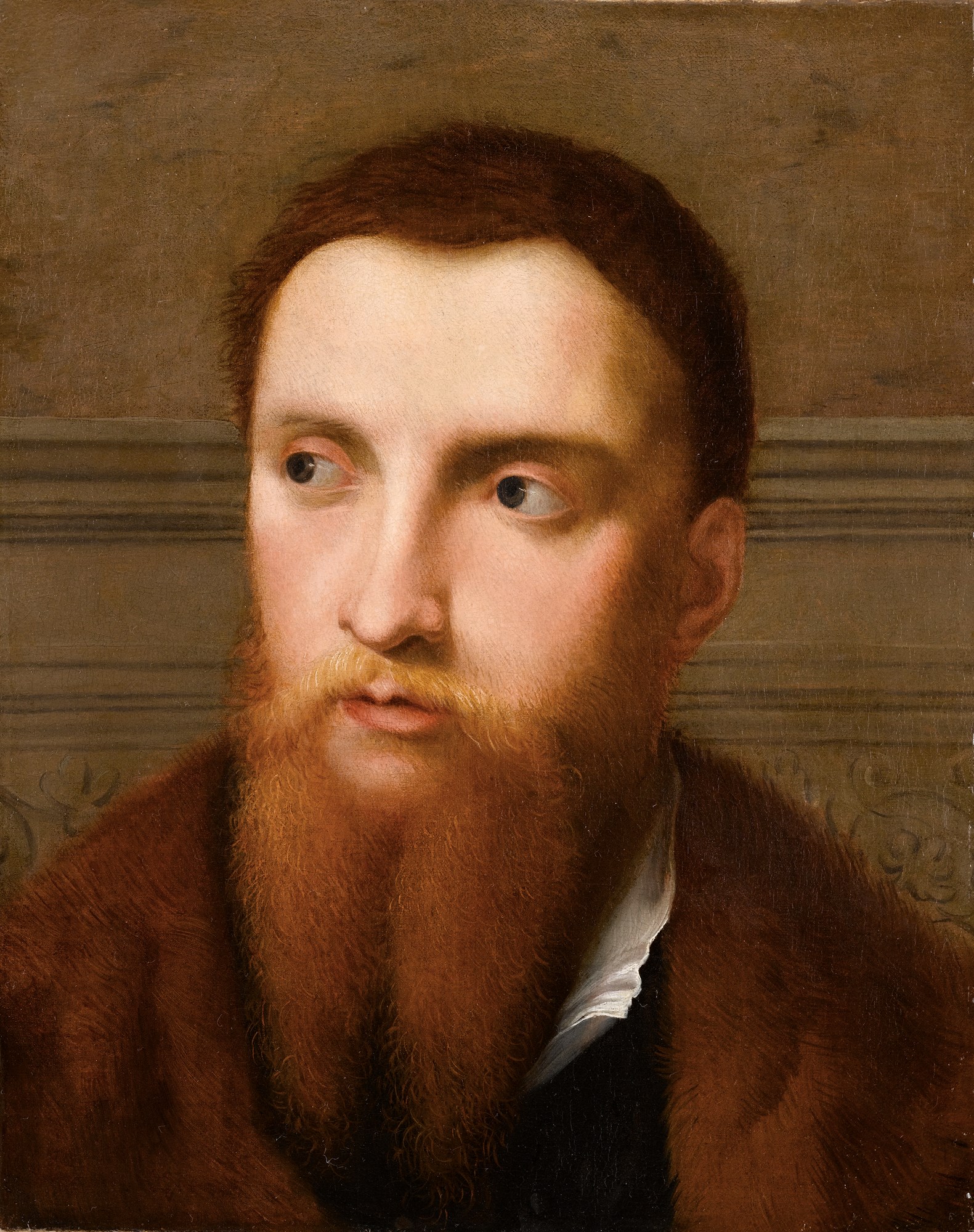Marketplace
Portrait of a Gentleman
Paris Bordone
Portrait of a Gentleman
Period 1400-1600, 16th Century
Origin Italy
Medium Oil on canvas
Dimension 40 x 31 cm (15³/₄ x 12¹/₄ inches)
In this portrait, we are presented with a demonstration of Paris Bordone’s exceptional talent. The subject seems preoccupied, as he gazes out of the picture plane, and his fur-lined coat and the classical frieze in the background, hint at his affluence. The work demonstrates Bordone’s great ability in rendering a variety of colours and textures. The slightly wispy nature of his beard and blond moustache contrasts with the thickness of his coat, although both are executed with the same short sharp brushstrokes. Similarly the soft rich pink of his cheeks, emphasising his youth, contrasts with the cool hard stone of the background. Although the identity of the sitter is unknown, he was clearly a figure of some importance, reflected in the fact that Bordone painted a second, slightly larger version of our portrait. ¹ However, scholars are divided over the dating of these portraits, with opinions ranging from c.1527 to c. 1550.²
The present work is typical of Bordone’s portraits, in which his talent is often in evidence, comparable to the Uffizi’s Portrait of Teofilo Folegno. Again the subject does not meet the viewer’s gaze, and this creates a sense of psychological depth and means the viewer is intrigued by the thoughts of the sitter. The dress of both figures is understated but clearly luxurious, and conveys the sitters’ importance without the need for opulence. The works demonstrate the qualities that Bordone bought to his portraiture, such as his interest in capturing variations of tones and textures, or his subtle and sophisticated modelling of flesh tones.
Bordone entered the studio of Titian at the age of sixteen and had become an independent master within two years. However, he had left his master’s studio prematurely, as Titian apparently did not take kindly to the student who could imitate his style with such skill. The rift was so great that Titian took for himself Bordone’s first Venetian commission, the altarpiece of S Niccolò dei Frari in 1523. In addition to Titian (c. 1488/1490-1576), Bordone was also highly susceptible to the influence of Giorgione during the early stage of his career.
Having established his reputation in Venice, during the 1530s Bordone started to travel further afield for his commissions. He spent time in Fontainebleau, at the court of Francis I, and also had highly successful periods in Northern Italy, Bavaria and Poland. Although in art history he is sometimes eclipsed by his Venetian contemporaries such as Titian, Paolo Veronese (1528-1588) and Jacopo Tintoretto (1518-1594), Bordone was much sought after, and the present work is testament to his abilities.
We are grateful to Professor Peter Humfrey for endorsing the attribution.
¹ Donati, A. Paris Bordone Catalogo Ragionato (Edizioni dei Soncino, 2014), p. 379, no. 174.
² Ibid.
The present work is typical of Bordone’s portraits, in which his talent is often in evidence, comparable to the Uffizi’s Portrait of Teofilo Folegno. Again the subject does not meet the viewer’s gaze, and this creates a sense of psychological depth and means the viewer is intrigued by the thoughts of the sitter. The dress of both figures is understated but clearly luxurious, and conveys the sitters’ importance without the need for opulence. The works demonstrate the qualities that Bordone bought to his portraiture, such as his interest in capturing variations of tones and textures, or his subtle and sophisticated modelling of flesh tones.
Bordone entered the studio of Titian at the age of sixteen and had become an independent master within two years. However, he had left his master’s studio prematurely, as Titian apparently did not take kindly to the student who could imitate his style with such skill. The rift was so great that Titian took for himself Bordone’s first Venetian commission, the altarpiece of S Niccolò dei Frari in 1523. In addition to Titian (c. 1488/1490-1576), Bordone was also highly susceptible to the influence of Giorgione during the early stage of his career.
Having established his reputation in Venice, during the 1530s Bordone started to travel further afield for his commissions. He spent time in Fontainebleau, at the court of Francis I, and also had highly successful periods in Northern Italy, Bavaria and Poland. Although in art history he is sometimes eclipsed by his Venetian contemporaries such as Titian, Paolo Veronese (1528-1588) and Jacopo Tintoretto (1518-1594), Bordone was much sought after, and the present work is testament to his abilities.
We are grateful to Professor Peter Humfrey for endorsing the attribution.
¹ Donati, A. Paris Bordone Catalogo Ragionato (Edizioni dei Soncino, 2014), p. 379, no. 174.
² Ibid.
Period: 1400-1600, 16th Century
Origin: Italy
Medium: Oil on canvas
Dimension: 40 x 31 cm (15³/₄ x 12¹/₄ inches)
Provenance: Laurent Negro (1929-1996), Château de Gourdon, France;
by descent to his son Laurent Negro, Château de Gourdon, France;
his sale, Christie's, Paris, 30 March 2011, lot 487 (as 'follower of Moretto da Brescia').
Literature: Andrea Donati, Paris Bordone Catalogo Ragionato (Edizioni dei Soncino, 2014), p. 379, no. 174.1.
More artworks from the Gallery









